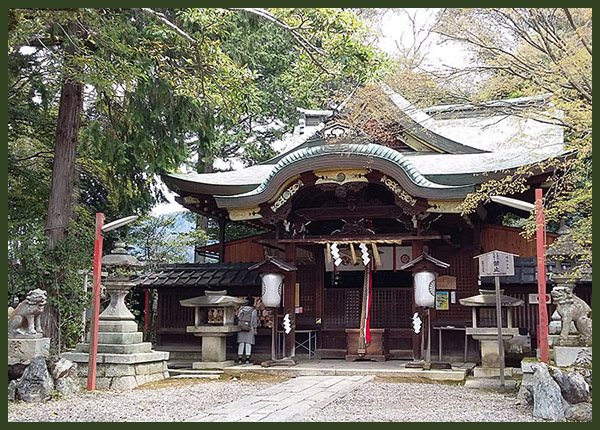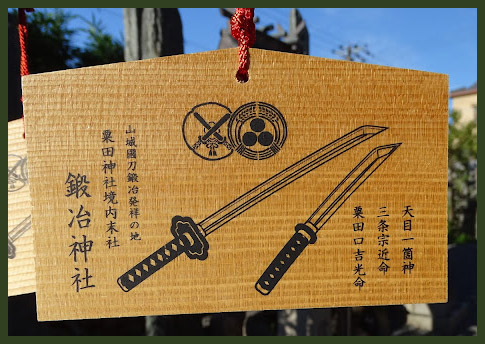. yakimono 焼物 / Setomono 瀬戸物 pottery, crockery .
:::::::::::::::::::::::::::::::::::::::::::::::::::::::::::::::::::::::::::::::::::::::::::::::::::::::::::::::::::::::::::::::::::::::::::::::::::::::::::::::::::::::::::
Awata yaki 粟田焼 Awata ware
quote
Awata ware 粟田焼 Awata-yaki / Awada-yaki
is a type of Japanese pottery that is a form of Kyō ware from Kyoto.
It is related to other Kyō wares such as Mizoro ware and Kiyomizu ware, but denotes the kiln it originates from.
The origin lies in the 粟田口 Awataguchi area of Kyoto
Awata kilns also produced Satsuma ware at one point.
source : wikipedia
三文字屋九右衛門 Sanmonjiya Kuemon
Kuemon, the ancestor of Awada-yaki Sanmonya,
was a Seto kiln worker who used the techniques of Seto pottery.
Later, Awada-yaki was combined with other techniques and developed into painted pottery.
..............................................................................................................................................
Tanzan Seikai 丹山青海 (1813 - 1886)
Seikai wrote a book in 1872 :
Tōki benkai 陶器辨解 Toki Benkai
Ceramics Dictonary / Ceramics Explained, lit. translated
In 1848, Seikai established a kiln in Nakanomachi, Awataguchi.
- reference source : japanese-ceramics.com ... -
..............................................................................................................................................
- quote -
Awata Taisai 粟田大祭 Great Festival at Awata Shrine
Most shrines hold a taisai, or "grand/main festival", each year, usually centered around a parade through the area where community members shoulder a giant portable shrine. However, not all grand festivals are cut from the same cloth! Awata Shrine, a small shrine located in northern Higashiyama near famous temples Shōren-in and Chion-in, boasts a colorful and exciting series of annual rituals and parades in early to mid-October.
- - - Reiken Ceremony
Awata Shrine's daitōrō, "Awata O-toro", large lanterns made up of traditional Japanese paper painted and shaped to look like mythological creatures and deities, are assembled for a parade through the Higashiyama area. While the lanterns look interesting enough in the daytime, they really come to life when night falls and they're lit up from the inside! Deities such as the Immovable Wisdom King Fudō Myō'ō and Lucky God Ebisu make appearances alongside the fearsome Ox-Headed Heavenly King and serpentine Onamuchi, as well as zodiac animals.
These lanterns are part of a procession containing shrine treasures and torches that heads down to the Chion-in where a rare ritual occurs! Priests from the Shinto shrine and monks from the Buddhist temple join together for the Reiken ceremony in which they pay their respects to the Uryūseki, a sacred stone.
- - - Shinkō-sai Procession
The Shinko-sai procession is held to celebrate taking the shrine's god out in a portable shrine (omikoshi) to survey the neighborhood.
However, Awata Shrine doesn't only have an omikoshi, but also features some of the community's eighteen kenboko, sacred polearms said to ward off evil spirits, each featuring a distinct design.
Watching the tall weapons skillfully carried through the streets by talented bearers who can make the poles shake and ring bells at their tops is definitely one of the original points of Awata Shrine's Taisai! Even just walking around the area can be an adventure, as some kenboko are housed on display around the neighborhood along with relics and altars.
Giant lantern floats light up the night, and the next day a 1.2-ton portable shrine is carried through the streets by a total of 250 people, preceded by long poles rising into the sky, balanced by people on foot.
Dating back 1,000 years, Awata Matsuri is a syncretic festival involving both Buddhism and Shinto.
- source : discoverkyoto.com/event ... -
Awata-jinja Shrine has a very long history.
Kyoto became the capital of Japan in 794.
The shrine was already built before 794 and got its name from a clan that lived in this region.
source : kyoto_awatajinja_shrine ...
Awataguchi Kaji-cho, Higashiyama Ward, Kyoto City
Kaji Jinja 鍛冶神社 Kaji Shrine
:::::::::::::::::::::::::::::::::::::::::::::::::::::::::::::::::::::::::::::::::::::::::::::::::::::::::::::::::::::::::::::::::::::::::::::::::::::::::::::::::::::::::::
. Legends and Tales from Japan 伝説 - Introduction .
................................................................................. Fukui 福井県
今立郡 Imadate district 池田町 Ikeda town
In the 今立郡 Imadate district there are two boulders,
Osu-iwa 雄岩 and Mesu-iwa 雌岩, the male (husband) and female (wife) boulder.
Along the river 坂ノ下川 Sakanoshitagawa on top of the mountain there was the Osu-iwa. About 300 years ago at an earthquake, it fell down into the valley. Since then every night there is the sound of オーイ、オーイ」 Ooooi, Ooooi, when the boulder is calling for its mate.
To appease it an elder of the village in 粟田郡 the Awata district hit an arrow into the Osu-iwa and had the Buddha prayer 南無妙法蓮華経 Namu Myoho Rengekyo inscribed into the stone. Now the stone kept quiet.
But it is said that it 1000 nuns will have passed the Mesu-iwa, it will also fall down.
This has not yet happened though.
................................................................................. Okayama 岡山県
.......................................................................
真庭郡 Maniwa district 湯原町 Yubara town
Awata jooseki 粟田城跡 (あわたじょうせき) the remains of Awata castle
- source and more photos : ameblo.jp/inaba-houki-castle . . -
In Yubara, 見明戸 Miakedo, there is a memorial for seven people.
The lord of 粟田城 Awata castle and six retainers committed suicide here.
. shichinin misaki 七人ミサキ / 7人ミサキ "Misaki death of seven people" .
A group of persons who died in an accident, suicide or in unnatural circumstances, for example in a fire or at sea.
A Misaki curse for seven people.
..............................................................................................................................................
- reference : nichibun yokai database 妖怪データベース - 粟田
:::::::::::::::::::::::::::::::::::::::::::::::::::::::::::::::::::::::::::::::::::::::::::::::::::::::::::::::::::::::::::::::::::::::::::::::::::::::::::::::::::::::::::

. Join the MINGEI group on facebook ! .
. yakimono 焼物 / Setomono 瀬戸物 pottery, crockery .
. Regional Folk Toys from Japan .
. Edo no shokunin 江戸の職人 Edo craftsmen .
. Tohoku after the BIG earthquake March 11, 2011
[ . BACK to WORLDKIGO . TOP . ]
[ . BACK to DARUMA MUSEUM TOP . ]
- - - ##awatayaki #awata #awada #kajijinja - - - - -
:::::::::::::::::::::::::::::::::::::::::::::::::::::::::::::::::::::::::::::::::::::::::::::::::::::::::::::::::::::::::::::::::::::::::::::::::::::::::::::::::::::::::::









No comments:
Post a Comment